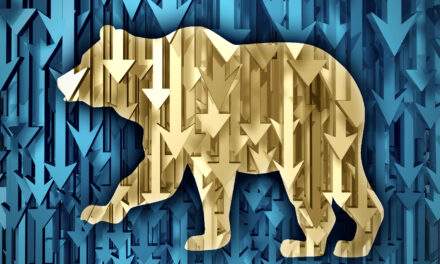Inflation has always been a problem. It’s just usually a quieter problem.For most of the past decade, inflation has been at 2% or lower. Barely enough to notice it. Consumers were blissfully unaware about inflation or how it worked.
These days, it’s a universal talking point. With the Consumer Price Index persistently above 8%, consumers can’t help but notice the pain of inflation every time they leave their house. Gas prices are up. So is food. Along with everything else at Walmart.
Staying home doesn’t help… Utility bills are also up. The cold winter weather right around the corner could make that worse.
In our frustration, we imagine someone, somewhere, must be benefiting from these higher prices. Especially if you listen to the arguments some make about corporate price gouging.
You may even hear these arguments and think corporations are making more money than ever, and stock prices should rise. But that may not be the case.
Inflation actually stands to crush corporate profits. And that will make an already bad bear market even worse.
There are two good reasons to expect this, and we’ll cover them today. But the important thing to understand now is, like I said on Monday, we’re nowhere near the bottom of this bear market.
And the sooner you realize this, the sooner you’ll start making moves that put you ahead…
Trickle-Up Pain
Corporations, just like consumers, face higher costs when inflation rises. Higher prices for raw materials, higher prices for utilities, and higher wages for employees.
They hope to pass those costs on to consumers… but that’s not always possible. Quickly raising prices can tarnish goodwill from consumers, spurring them to look elsewhere for what they need.
Businesses understand this. For proof, look no further than the Costco co-founder allegedly saying of the wholesaler’s $1.50 hot dog combo: “If you raise (the price of the) effing hot dog, I will kill you. Figure it out.”
That’s funny, and hopefully true, but there’s even more solid proof.
Earnings reports from the last three quarters show companies are eating some of the increased costs. We know that because profit margins are contracting. Companies are earning less for every dollar as sales. As consumers struggle and sales contract, earnings will fall. And lower earnings mean lower stock prices.
With inflation, it turns out that the pain trickles up just as much as it trickles down.
That brings us to the second way inflation hurts earnings: interest rates.
The Federal Reserve has been raising interest rates to fight inflation. The idea is that a higher cost of borrowing will slow down consumer demand, which helps the supply side catch up.
But raising interest rates affects more than just the consumer. With higher rates, companies face higher interest expenses on their debt.
Over the past 15 years, the average interest rate companies pay fell by half. In 2007, borrowing costs for the average company in the S&P 500 were 6%. In 2022, that fell to 3%.
Companies responded to the lower interest rates of the last 15 years by borrowing more. Corporate debt rose from about 26% of assets to 35%.
The chart below from 2002 to 2021 shows the relationship between debt and interest rates. The average level of corporate debt is on the left-hand scale. Interest rates are on the right-hand scale. The relationship is predictable – as rates fall, debt increases.

Data from Federal Reserve.
(Click here to view larger image.)
The relationship is now flipping. Rates are rising while growth slows, so companies will prioritize paying off debt that accrues interest at a faster rate than their expected returns.
And here’s where we get to the bearish picture for stocks.
Don’t Be Fooled – This Bear’s Not Over
Lowering debt will help companies reduce costs in a higher interest rate environment. But it also reduces investment in new opportunities.
That reduces future profits and makes stocks less valuable, lowering fundamental metrics like the price-to-earnings ratio.
Let’s look at an example from history…
The last time inflation was this high was the late 1970s. Just like now, the Fed raised interest rates to try to slow it down.
The P/E ratio for the S&P 500 fell 43% as the Fed raised interest rates from 1976 to 1981.

Data from Dr. Robert Shiller.
(Click here to view larger image.)
This is another reason to expect low returns in the long run. Until inflation is under control, the Fed will keep raising rates. That’s historically weighed on stock prices and this time will be no different.
There are a few ways you can respond to this reality.
- You can eternally “buy the dip” and hope you catch the bottom.
- You can swear off investing and trading entirely, letting inflation erode your wealth.
- You can start trading a system that has proven to outperform the markets in good or bad times.
I may be a bit biased toward #3, but I have good reason to be.
My career has taught me the best way to avoid large losses in your portfolio is to trade for the short term.
There will be many rallies, and many declines, as we proceed through this bear market. Focusing on the short run allows us to avoid the painful adjustments that need to occur.
Mike Carr’s trading system, which has posted a 78% return in 2022 despite the S&P 500 falling 20%, is a perfect example of this.
Mike trades just one ticker, once per week, and often captures triple-digit returns in a matter of days.
He isn’t waiting for stocks to recover from this bear market. He’s hoping volatility sticks around, making opportunities like these more frequent.
On November 15, at 8 p.m. ET, Mike’s going live with a deep-dive presentation about how his system works.
Mike believes right now is the best time in years to start using this system, so make sure you attend with an open mind and a notepad at the ready.
Just click right here to confirm your attendance.
Regards,
 Amber HestlaSenior Analyst, True Options Masters
Amber HestlaSenior Analyst, True Options Masters










